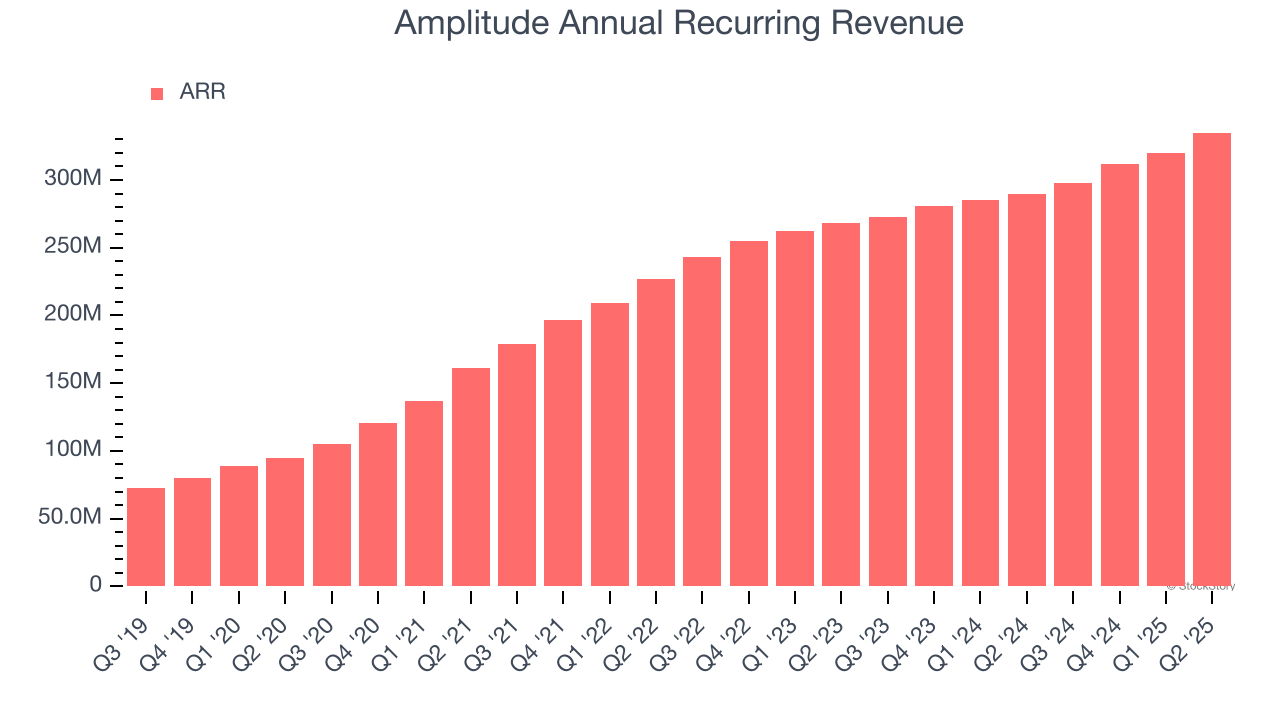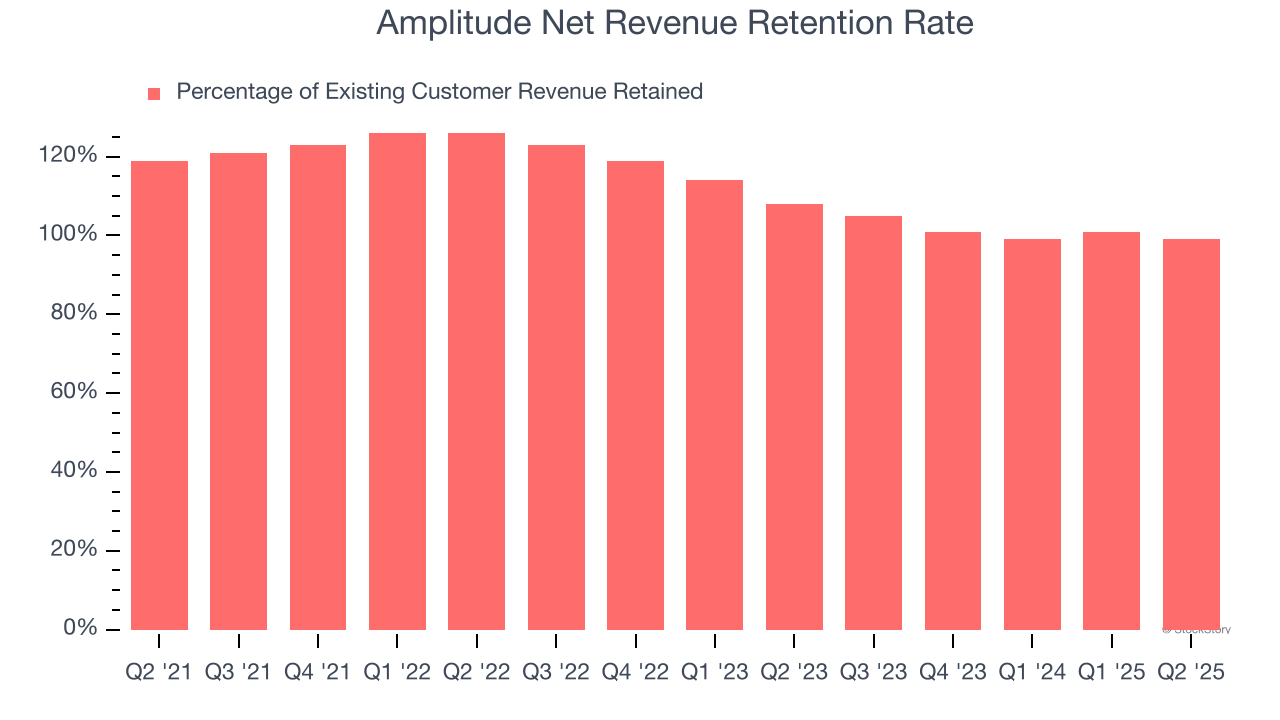
Data analytics software provider Amplitude (NASDAQ: AMPL) announced better-than-expected revenue in Q2 CY2025, with sales up 13.6% year on year to $83.27 million. On top of that, next quarter’s revenue guidance ($86 million at the midpoint) was surprisingly good and 3.4% above what analysts were expecting. Its non-GAAP profit of $0.01 per share was in line with analysts’ consensus estimates.
Is now the time to buy Amplitude? Find out by accessing our full research report, it’s free.
Amplitude (AMPL) Q2 CY2025 Highlights:
- Revenue: $83.27 million vs analyst estimates of $81.35 million (13.6% year-on-year growth, 2.4% beat)
- Adjusted EPS: $0.01 vs analyst estimates of $0.01 (in line)
- Adjusted Operating Income: -$1.48 million vs analyst estimates of -$1.54 million (-1.8% margin, relatively in line)
- The company lifted its revenue guidance for the full year to $336.7 million at the midpoint from $331 million, a 1.7% increase
- Operating Margin: -32.5%, up from -37.1% in the same quarter last year
- Free Cash Flow was $18.17 million, up from -$9.23 million in the previous quarter
- Customers: 634 customers paying more than $100,000 annually
- Net Revenue Retention Rate: 99%, down from 101% in the previous quarter
- Annual Recurring Revenue: $335 million at quarter end, up 15.5% year on year
- Market Capitalization: $1.6 billion
Company Overview
Born out of a failed voice recognition startup by founder Spenser Skates, Amplitude (NASDAQ: AMPL) is data analytics software helping companies improve and optimize their digital products.
Revenue Growth
A company’s long-term sales performance is one signal of its overall quality. Even a bad business can shine for one or two quarters, but a top-tier one grows for years. Over the last three years, Amplitude grew its sales at a 15.4% compounded annual growth rate. Although this growth is acceptable on an absolute basis, it fell slightly short of our standards for the software sector, which enjoys a number of secular tailwinds.

This quarter, Amplitude reported year-on-year revenue growth of 13.6%, and its $83.27 million of revenue exceeded Wall Street’s estimates by 2.4%. Company management is currently guiding for a 14.3% year-on-year increase in sales next quarter.
Looking further ahead, sell-side analysts expect revenue to grow 9.8% over the next 12 months, a deceleration versus the last three years. This projection doesn't excite us and implies its products and services will face some demand challenges.
Software is eating the world and there is virtually no industry left that has been untouched by it. That drives increasing demand for tools helping software developers do their jobs, whether it be monitoring critical cloud infrastructure, integrating audio and video functionality, or ensuring smooth content streaming. Click here to access a free report on our 3 favorite stocks to play this generational megatrend.
Annual Recurring Revenue
While reported revenue for a software company can include low-margin items like implementation fees, annual recurring revenue (ARR) is a sum of the next 12 months of contracted revenue purely from software subscriptions, or the high-margin, predictable revenue streams that make SaaS businesses so valuable.
Amplitude’s ARR punched in at $335 million in Q2, and over the last four quarters, its growth slightly outpaced the sector as it averaged 12% year-on-year increases. This alternate topline metric grew faster than total sales, which likely means that the recurring portions of the business are growing faster than less predictable, choppier ones such as implementation fees. That could be a good sign for future revenue growth. 
Customer Retention
One of the best parts about the software-as-a-service business model (and a reason why they trade at high valuation multiples) is that customers typically spend more on a company’s products and services over time.
Amplitude’s net revenue retention rate, a key performance metric measuring how much money existing customers from a year ago are spending today, was 100% in Q2. This means Amplitude would’ve grown its revenue by 0% even if it didn’t win any new customers over the last 12 months.

Amplitude has an adequate net retention rate, showing us that it generally keeps customers but lags behind the best SaaS businesses, which routinely post net retention rates of 120%+.
Key Takeaways from Amplitude’s Q2 Results
We enjoyed seeing Amplitude beat analysts’ annual recurring revenue expectations this quarter. We were also glad its revenue guidance for next quarter exceeded Wall Street’s estimates. On the other hand, its net revenue retention declined. Overall, we think this was a decent quarter with some key metrics above expectations. The stock remained flat at $12.22 immediately following the results.
Is Amplitude an attractive investment opportunity right now? When making that decision, it’s important to consider its valuation, business qualities, as well as what has happened in the latest quarter. We cover that in our actionable full research report which you can read here, it’s free.





